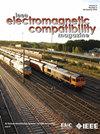基于传导性调制效应的非互易超宽带能量选择天线
IF 2
3区 计算机科学
Q3 ENGINEERING, ELECTRICAL & ELECTRONIC
IEEE Transactions on Electromagnetic Compatibility
Pub Date : 2024-10-08
DOI:10.1109/TEMC.2024.3471686
引用次数: 0
摘要
提出了一种利用电导率调制效应实现非互易能量选择天线的方法。NESA可以保护敏感的Rx前端免受高功率微波威胁,同时允许在Tx通道中正常传输无线信号。提出的NESA由一个传输模块、一个整流电路和一个加载了正本征负(PIN)二极管的超宽带天线组成。传输模块识别导波方向,控制整流电路选择PIN二极管调制方式。当NESA工作在Rx状态时,PIN二极管受直流电导调制控制,以较低的阈值进入防御模式。相反,当工作在Tx状态时,PIN二极管受射频(RF)电导调制控制,NESA将不进入防御模式,允许正常的功率传输。为了演示这个新概念,我们制作并测量了一个使用维瓦尔第天线的设计。理论、数值和实验结果与原型天线吻合良好。该原型在2-6 GHz的频率范围内工作,允许传输高达20 W的连续波信号,并在整个频段内提供~ 20 dB的防御水平。该原型在正常模式下具有25db的非互易性和~ 1db的插入损耗。增加的电路体积小,不需要直流电源,这对保护宽带前端和阵列很有用。本文章由计算机程序翻译,如有差异,请以英文原文为准。
A Non-Reciprocal, Ultrawideband Energy Selective Antenna Based on Conductivity Modulation Effect
This article presents a realization of nonreciprocal energy selective antenna (NESA) using conductivity modulation effect. NESA can protect sensitive
Rx
frontend from high power microwave threats while permitting a normal transmission of wireless signals in the
Tx
channel. The proposed NESA consists of a transmission module, a rectifier circuit, and a ultrawideband antenna loaded with positive-intrinsic-negative (PIN) diodes. The transmission module discriminates the direction of guided wave and controls the rectifier circuit to select the modulation mode of PIN diodes. When NESA operates in the
Rx
state, PIN diodes are controlled by the dc conductance modulation, and it enters the defense mode at a lower threshold. Conversely, when operating in the
Tx
state, PIN diodes are controlled by radio frequency (RF) conductance modulation, NESA will not enter the defense mode and allow normal power transmission. To demonstrate this new concept, a design using a Vivaldi antenna is fabricated and measured. The theoretical, numerical, and experimental results agree well for the prototype antenna. The prototype operates in the frequency range of 2–6 GHz, allowing for the transmission of continuous wave signals up to 20 W, and providing ∼20 dB of defense level across the entire band. The prototype exhibits 25 dB of nonreciprocity and ∼ 1 dB of insertion loss in the normal mode. The added circuitry has a small size and requires no dc power supply, which is useful for protecting broadband front-ends and arrays.
求助全文
通过发布文献求助,成功后即可免费获取论文全文。
去求助
来源期刊
CiteScore
4.80
自引率
19.00%
发文量
235
审稿时长
2.3 months
期刊介绍:
IEEE Transactions on Electromagnetic Compatibility publishes original and significant contributions related to all disciplines of electromagnetic compatibility (EMC) and relevant methods to predict, assess and prevent electromagnetic interference (EMI) and increase device/product immunity. The scope of the publication includes, but is not limited to Electromagnetic Environments; Interference Control; EMC and EMI Modeling; High Power Electromagnetics; EMC Standards, Methods of EMC Measurements; Computational Electromagnetics and Signal and Power Integrity, as applied or directly related to Electromagnetic Compatibility problems; Transmission Lines; Electrostatic Discharge and Lightning Effects; EMC in Wireless and Optical Technologies; EMC in Printed Circuit Board and System Design.

 求助内容:
求助内容: 应助结果提醒方式:
应助结果提醒方式:


